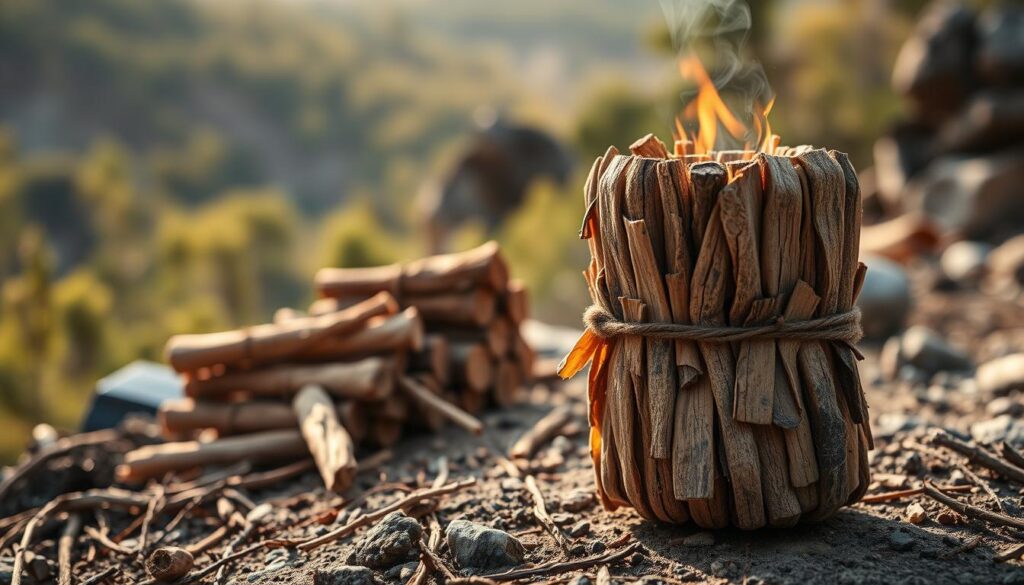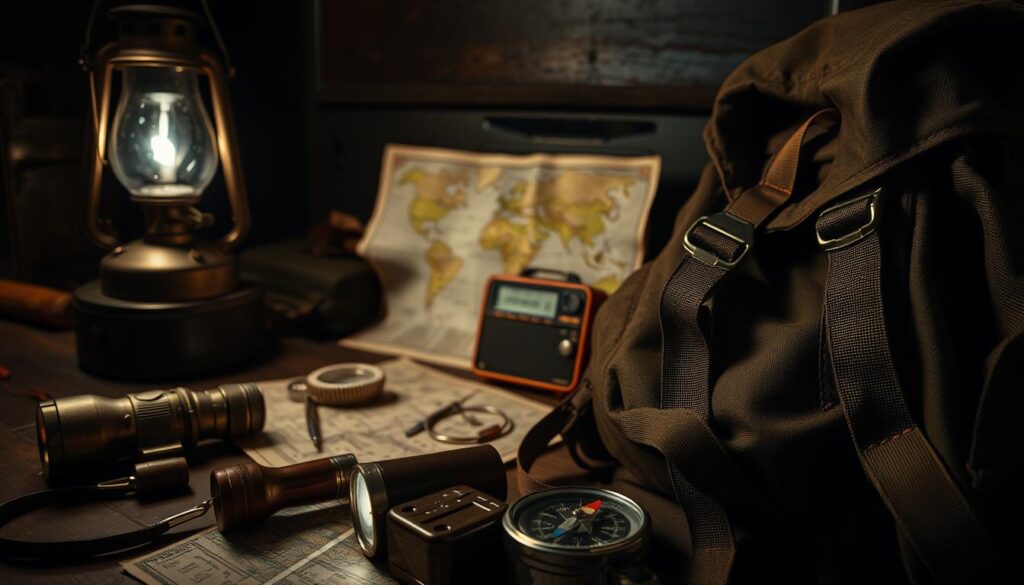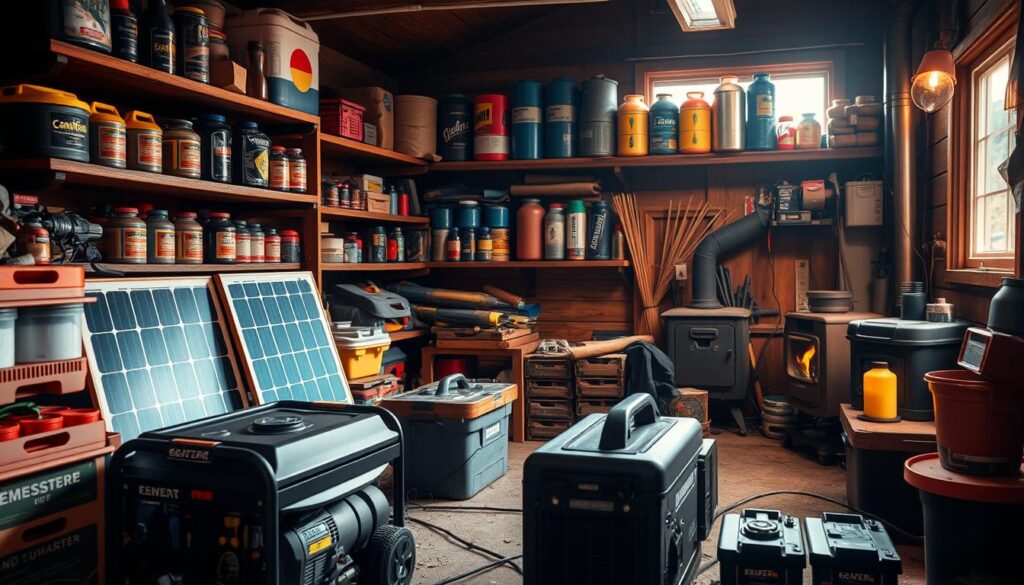As an outdoor lover, I’ve faced the challenge of starting a reliable fire starter in damp or windy weather. A durable fire starter is more than just a handy tool. It’s essential for a safe and fun outdoor adventure.
Making a durable fire starter is easier than you think. With a few common items, you can make a long-lasting fire starter for all your outdoor trips.
Key Takeaways
- Learn how to create a durable fire starter using simple materials.
- Understand the importance of a reliable fire starter for outdoor activities.
- Discover how to make your fire starter last longer.
- Find out how to prepare for unexpected weather conditions.
- Gain confidence in your ability to start a fire when it matters most.
Understanding the Importance of a Long-Lasting Fire Starter
A durable fire starter is key for camping and backpacking. It’s vital for starting fires, which are needed for cooking, warmth, and signaling for help.
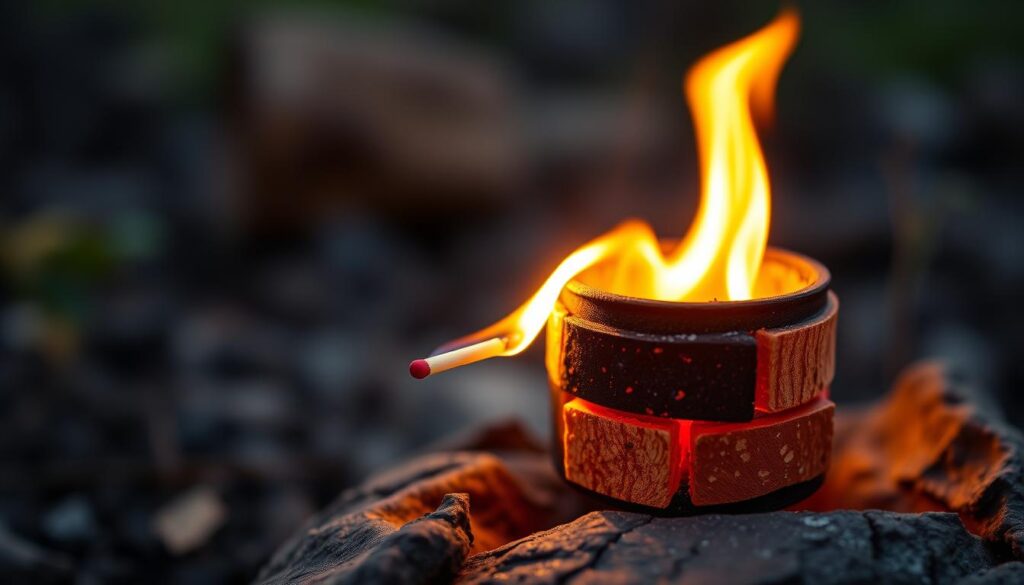
Why You Need a Reliable Fire Starter
A reliable fire starter is vital for outdoor adventures. It helps start fires even in damp or wet conditions. This is important for safety and comfort while camping or backpacking.
With a good fire starter, you can cook warm meals, stay warm, and signal for help if needed. It also means you don’t have to replace or repair it often, making it handy for long trips or frequent outdoor activities.
Common Uses for Fire Starters
Fire starters are not just for starting campfires. They can also light stoves, fireplaces, and even cigarettes outdoors. For campers and backpackers, a fire starter is a must-have. It’s used for cooking, warmth, signaling, and setting the mood.
Some common uses for fire starters include:
- Camping and backpacking
- Outdoor cooking
- Signaling for help in emergency situations
- Providing warmth during cold weather
Knowing the importance and uses of fire starters helps outdoor lovers see their value. A reliable and long-lasting fire starter is essential for any adventure.
Essential Materials for My Fire Starter
The quality of a fire starter’s materials is key. To make a eco-friendly fire starter, picking the right stuff is essential.
Using natural materials makes the fire starter better and more sustainable. I’ll talk about what you need and how to pick it.
Choosing the Right Base Components
Fire starters can use different bases. Waxes like paraffin or soy wax are popular because they burn well and are easy to work with. Look at the wax’s melting point and how long it burns to see if it fits your needs.
| Material | Burn Time | Ease of Use |
|---|---|---|
| Paraffin Wax | Medium | Easy |
| Soy Wax | Long | Moderate |
| Beeswax | Long | Moderate |
Adding Natural Flammable Materials
Adding natural flammable stuff makes the fire starter better. Dryer lint, sawdust, and small twigs are great because they burn well and are easy to find.
Make sure these materials are dry. Moisture can stop them from lighting up. I mix dryer lint with melted wax to make a compact fire starter that’s tough and simple to use.
By picking and mixing these materials carefully, you can make a top-notch natural fire starter. It’s perfect for camping, emergencies, or other needs.
Step-by-Step Guide to Making My Fire Starter
To make a durable fire starter, I first prepare my workspace. I clear a flat surface and gather all needed materials nearby.
Preparing Your Workspace
I make sure my workspace is clean, dry, and organized. I have a heat-resistant surface and a double boiler or a makeshift one. I also have all the ingredients and tools ready.
Mixing and Combining Ingredients
With my workspace ready, I melt the wax in the double boiler. Once it’s melted, I mix it with other flammable materials. I make sure they’re evenly spread out.
The wax to flammable material ratio can be adjusted. This affects the fire starter’s size and burn time.
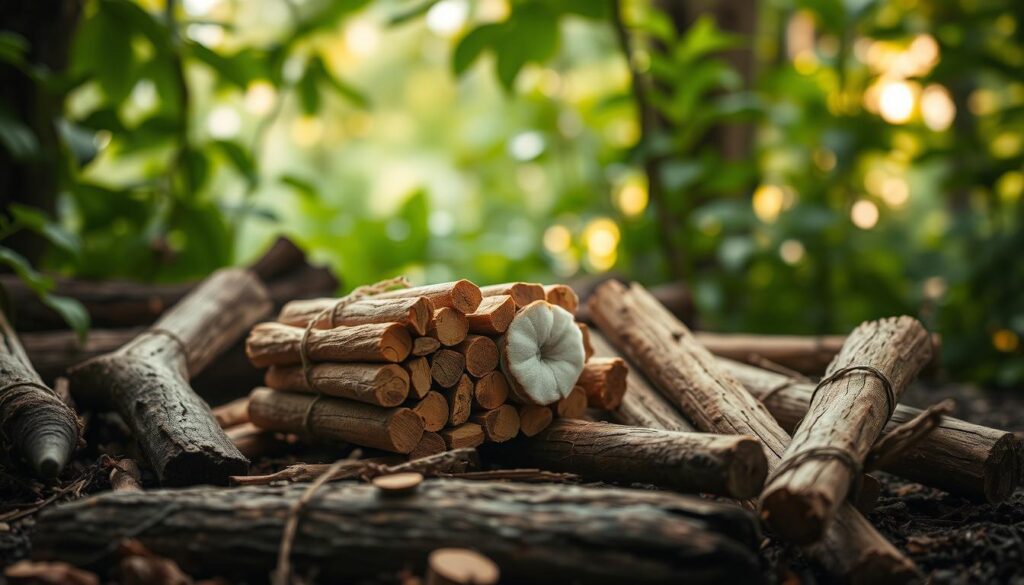
After mixing, I shape the mixture into a compact form. It must be dry and have no excess wax on the surface. This step is key for a durable fire starter that works well in different conditions.
Techniques for Increasing Durability
I’ve found that making a fire starter last longer needs special techniques. These methods help my fire starter work well in different conditions.
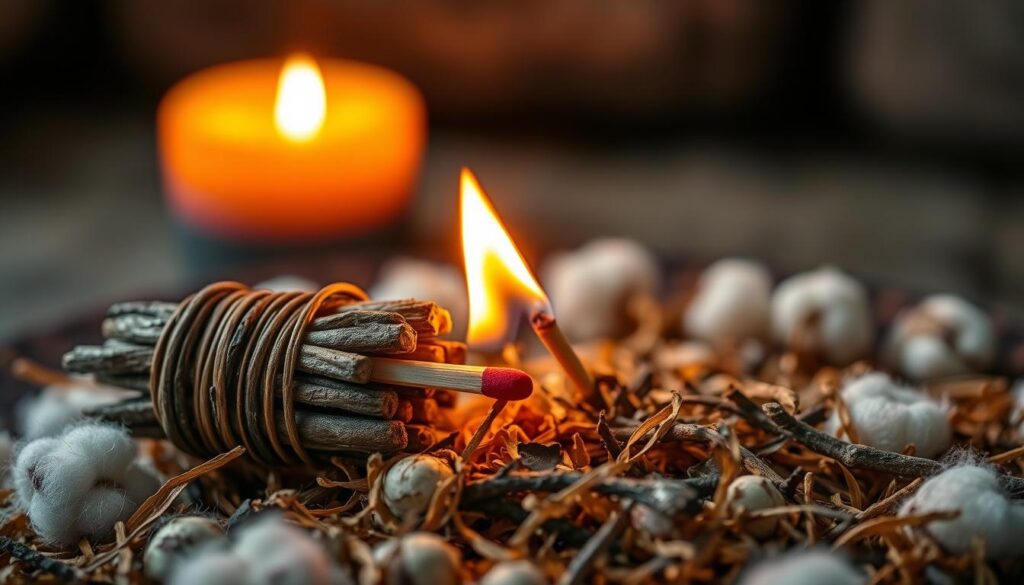
Sealing for Longevity
Sealing a fire starter with a protective layer is very effective. I use wax or varnish to keep mine safe from moisture and other damage. For more tips on safe fire starting, check out this resource.
Testing for Effectiveness
It’s important to test my fire starter in different places. This makes sure it lights up easily and burns long enough to start a bigger fire. Testing helps me find any problems and fix them to make a durable fire starter.
By sealing and testing my fire starter, I know it’s both long-lasting and reliable, even in tough situations.
Storage Tips for My Fire Starters
Storing fire starters right can make them last longer. It’s key to keep them in good shape.
Choosing the right container is as important as the fire starter itself. Waterproof containers are a must to keep them dry and ready.
Best Containers for Keeping Fire Starters Dry
Using airtight, waterproof containers is the best storage method. These containers keep moisture out, keeping the fire starter working well.
- Plastic containers with tight-fitting lids
- Metal tin containers with rubber seals
- Waterproof bags or pouches
With the right container, my fire starters stay effective, even in damp conditions.
Labeling and Organizing Your Supplies
Labeling and organizing my fire starters is just as important. It makes it easy to find the right one when I need it.
I use clear labels to show the fire starter type, the date it was made, and other important details. This helps me manage my supplies well and use the best fire starter for the job.
| Label Information | Purpose |
|---|---|
| Type of Fire Starter | Helps identify the fire starter |
| Date Made | Ensures older fire starters are used first |
| Additional Notes | Provides extra context for use |
Safety Considerations When Making Fire Starters
When making a fire starter, safety is key. I need to be careful with the materials I choose and where I work.
Handling Flammable Materials
I must handle flammable materials with care to avoid accidents. I store them in a well-ventilated area, away from heat sources. I use them in a controlled environment and follow the manufacturer’s instructions.
When working with flammable materials, I should be aware of my surroundings. I make sure a fire extinguisher or other safety measures are nearby.
Proper Disposal of Waste
Proper disposal of waste is essential to maintaining a safe environment. I dispose of any waste materials according to local regulations and guidelines. This includes disposing of packaging materials, leftover flammable substances, and other waste generated during the fire starter creation process.
By handling flammable materials with care and disposing of waste properly, I can create a safe fire starter and ensure a reliable fire starter for my camping or backpacking needs.
Environmental Impact of Homemade Fire Starters
When I make my own fire starters, I think about their effect on the environment. The materials I pick and how I throw them away matter a lot. It’s all about making my DIY project better for the planet.
Creating eco-friendly fire starters means picking materials that are good for the earth. I use natural wax like beeswax or soy wax because they break down easily and are safe. I also add recycled paper or cardboard to make them even greener.
Sustainable Material Choices
Picking the right stuff is key to keeping my fire starters green. I choose materials that are easy to find, can grow back, and don’t hurt the environment. For example, using cotton or hemp for the wick is better than synthetic stuff.
Using recycled stuff is another big plus. By using recycled paper or cardboard, I cut down on landfill waste. It saves natural resources and lowers carbon emissions too.
Recycling and Reusing Components
Recycling and reusing is a big part of making my fire starters eco-friendly. I look for ways to use materials that would be thrown away. Like melting down old candles or wax to make new fire starters.
I also think about how I package and store my fire starters. Using containers or bags that can be used again helps reduce waste. It keeps my fire starters dry and ready to go.
By following these steps, I can enjoy my natural fire starters and know they’re good for the planet.
Alternatives to My Homemade Fire Starters
If you don’t want to make your own fire starters, there are many store-bought options. They can meet your needs just as well.
Store-Bought Options
Store-bought fire starters, like lighters and matches, are easy to use. They are made for outdoor activities, such as backpacking and camping.
Comparing Performance and Cost
When picking between homemade and store-bought fire starters, look at their performance and cost. Store-bought ones might last longer and work better. But, they can cost more over time.
Personal Experiences with Fire Starters
My journey with fire starters has been enlightening. I’ve learned a lot about durable fire starters and the need for a reliable fire starter. Through trial and error, I’ve figured out what makes a fire starter work well and last long.
At first, making fire starters was a mixed bag. I faced many hurdles, from picking the right stuff to keeping it dry. But each failure taught me something new, helping me get better.
Lessons Learned from My Early Attempts
One key lesson was about choosing the right base materials. I found that dryer lint, wax, and sawdust make a reliable fire starter. It’s easy to make and works well.
Here’s a quick rundown of my early tries and what I learned:
| Attempt | Materials Used | Outcome | Lesson Learned |
|---|---|---|---|
| 1 | Dryer lint and wax | Effective but not durable | Need for a more durable coating |
| 2 | Sawdust and wax | Durable but slow to ignite | Importance of balancing durability and ignitability |
| 3 | Combination of dryer lint, wax, and sawdust | Both durable and effective | Optimal mix of materials is key |
Improvements I've Made Over Time
As I kept trying, I made some big changes to my recipe. I started using a better mix of materials and a consistent wax application. This made my fire starters more reliable.
Sealing the starters with wax made them last longer. I also tried different waxes to see which worked best.
By tweaking my method and trying new stuff, I’ve made durable fire starters that work great. My journey shows that with the right mix and practice, anyone can make good fire starters.
Frequently Asked Questions About Fire Starters
Exploring different ways to make a reliable fire starter has led to many questions. I’ll answer these and share tips for using your fire starter well. This will help you in various situations.
Addressing Common Concerns
Many worry about the durability and lasting power of fire starters. To make a long-lasting fire starter, pick the right materials and prepare them correctly. Mixing natural flammable materials with a binding agent boosts performance.
Tips for Optimal Use
To use your compact fire starter best, know how to handle it. Store it in a dry, safe place and follow the ignition instructions. This ensures a great camping or backpacking trip.
FAQ
What is the best material to use for a long-lasting fire starter?
I suggest using natural wax like beeswax or paraffin wax as the base. Adding dryer lint or shredded paper can make it burn longer.
How do I make my fire starter waterproof?
To make it waterproof, seal the mixture with wax or varnish. This keeps it dry and effective in wet conditions.
What are some eco-friendly alternatives for making fire starters?
I use recycled paper and natural wax to be kind to the environment. Cotton balls or dryer lint are also good options.
How do I store my fire starters to keep them dry and effective?
Store them in waterproof containers like plastic bags or airtight cans. Labeling and organizing makes them easy to find.
Can I use store-bought fire starters instead of making my own?
Yes, you can buy fire starters like lighters or commercial ones. I compare them to see which is best for me.
How can I improve the durability of my homemade fire starters?
To make them last longer, seal with wax or varnish. Testing them in different conditions helps too.
What safety precautions should I take when making fire starters?
Be careful with flammable materials and dispose of waste properly. Keep your workspace well-ventilated and distraction-free.
Can I use my fire starter for purposes other than camping or backpacking?
Yes, fire starters are great for cooking, warmth, and signaling. They’re essential for many outdoor activities.
How do I know if my fire starter is effective?
Test it in different conditions to check if it works. If it doesn’t light well, adjust your recipe and try again.

